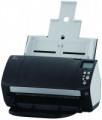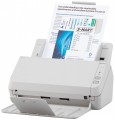Optical element
— CIS, abbreviation for "Contact Image Sensor" — contact image sensor. The simplest type of optical element: it is a line across the entire width of the scanner's working space, on which photocells that read the image and LEDs that provide illumination are located in a row. They are inexpensive and take up little space, which, accordingly, makes the scanners themselves cheaper and smaller. On the other hand,
CIS sensors have a shallow depth of field, and even small bumps in the scanned image can be out of focus. However, in general, they are quite suitable for both personal and not too complex professional tasks.
— CCD, short for "Charge-Coupled Device" — a charge-coupled device. A much more complex design than CIS, includes a fluorescent lamp, lens and mirror.
CCD scanners are larger, heavier and much more expensive than their counterparts in CIS. On the other hand, this type of optical element provides high-quality colour reproduction and a good depth of field, coping well with complex-shaped media. Therefore, advanced professional scanners are usually equipped with a CCD.
— CMOS. The abbreviation for "Complementary Metal-Oxide-Semiconductor" is a complementary metal-oxide-semiconductor structure (the designation CMOS is also used in Russian). A key feature
of CMOS sensors is that they capture the scanned image as a whole, similar to photography (and not
...line by line, as in other types of optical elements). In fairness, it should be noted that the "instantaneous" scanning does not give a tangible advantage in speed, because. processing the captured image takes quite a long time. However, this feature is extremely useful in cases where it is difficult to ensure the immobility of the scanned material and/or uniform movement of the optical element relative to this material. Such situations often arise when working with book and handheld scanners (see "Type"), so CMOS elements are most popular in such devices.Max. scan area
The maximum image size that the scanner can process at one time, both horizontally and vertically. You should pay attention to this parameter if you need the exact dimensions of the scanner's working area, down to a millimetre: although standard formats are used to designate these dimensions (see "Format"), in fact the dimensions may differ from them.
Colour depth (ext.)
External colour depth characterizes the maximum possible number of colour shades in the image transmitted by the scanner to the computer. A depth of 24 bits is considered quite enough for non-professional tasks, in more advanced models this parameter can reach 96 bits. For details on colour depths and their relationship, see "Colour Depth (Int.)"
Mono scanning
The black and white scanning speed provided by the device. Usually, the maximum processing speed for an A4 sheet is indicated, i.e. speed at the lowest resolution. In fact, the speed is usually lower and depends on both the resolution and the size of the original material. The higher the scanning speed, the more convenient it is to work with the scanner; pay special attention to this parameter if you plan to work with numerous black and white images.
Colour scanning
Colour scanning speed provided by the device. In fact, it depends on the selected resolution, colour depth and original dimensions; the characteristics most often indicate the speed for an A4 sheet at the minimum resolution and colour depth, i.e. maximum possible speed. If you only need to scan one or more sheets from time to time, high speed is not too critical, but for working with a large amount of materials, you should look for fast models.
Operating cycle
The maximum number of pages that the scanner can process per day without overloading and the negative consequences associated with them. Most often indicated for A4 format. Even the most modest models of modern scanners have duty cycles measured in dozens of pages, which is quite enough for simple everyday tasks. Therefore, you should pay attention to this parameter if you have to scan numerous materials every day.
Document autofeed
The maximum number of sheets of standard weight (80 g/m²) paper that can be placed in the scanner's auto feed system at a time. These systems are similar to those installed in printers: a stack of sheets is installed in a special tray, and each of them is fed in turn for scanning. It is worth paying attention to models with this function if you often have to work with numerous documents: you will not need to monitor the process and manually feed sheets — just load the originals into the automatic document feeder and press the button. Many document feeders, some flatbeds, and almost all combination scanners have an ADF (see "Type"). It works, however, only with separate sheets and cannot cope with larger media.
LCD screen
The scanner has its own
display. Such displays can vary from simple indicators that display a minimum of service information (selected mode, work process, some errors, etc.) to full-colour touch screens that significantly expand the capabilities of the device. Anyway, the display makes the operation of the scanner more convenient and intuitive.
Power consumption
The maximum power consumed by the scanner during operation. The higher the power, the more energy the scanner consumes, but this only applies to the scanning process itself — in standby mode, power consumption is negligible. And even at the peak in most models, the power is so low that in fact this parameter has practically no effect on electricity bills and is more of an auxiliary value (for example, it is used to calculate the total power of devices connected to an uninterruptible power supply).

